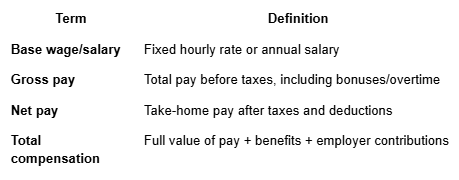What is total compensation?
Total compensation is the full value of everything an employee earns from their employer—not just their base wage or salary. It includes direct pay like hourly wages or salaries, as well as indirect pay such as bonuses, benefits, paid time off, employer-paid taxes, and other perks.
For small business owners, understanding and clearly communicating total compensation helps attract, retain, and engage great employees—especially in competitive hiring markets. And with tools like Homebase, you can better manage and track all components of employee pay in one system, making it easier to stay transparent, compliant, and organized.
What’s included in total compensation?
While many employees focus on their hourly wage or paycheck, their full compensation package is often worth much more. Total compensation typically includes:
Direct compensation
- Hourly wages or salary: Base pay earned for hours worked
- Overtime pay: Premium rates for hours worked beyond standard schedules
- Bonuses: Performance, attendance, or seasonal bonuses
- Commissions: Pay based on sales or production volume
- Tips: For tipped roles, this may be partially employer-managed
Indirect compensation
- Employer-paid payroll taxes: Your share of Social Security, Medicare, FUTA, and state taxes
- Health insurance contributions: Employer-paid portion of medical, dental, or vision plans
- Retirement contributions: Employer matching or contributions to 401(k) or IRA plans
- Paid time off (PTO): Vacation, sick days, and paid holidays
- Training and development: Courses, certifications, or job training covered by the business
- Fringe benefits: Uniform stipends, commuter benefits, employee meals, or wellness perks
- Other perks: Flexible scheduling, childcare assistance, or tuition reimbursement (if applicable)
All of these add up to the total value your employee receives in exchange for their work.
Why total compensation matters for employers
Whether you’re recruiting or trying to retain your team, you want to think beyond the literal dollars that your employees receive. Here’s why it’s important to understand total compensation:
- Attract talent: Job seekers aren’t just looking for a paycheck—they want to understand the full value of what they’re getting. If you only advertise a wage without mentioning PTO or health benefits, you might lose candidates to a competitor with a lower base wage but better overall compensation.
- Retain employees and raise morale: Employees who understand their full compensation are more likely to feel valued. If someone doesn’t realize you’re covering $500 a month in benefits, they may underestimate how much they’re really earning—and leave for what appears to be a slightly higher-paying job.
- Forecast your budget: Understanding the true cost of each employee helps employers plan ahead, allocate resources, and stay financially stable. Total compensation reporting makes labor costs more predictable and transparent.
- Foster trust and transparency: When employers clearly communicate the full compensation package, employees are less likely to feel underpaid or undervalued. This builds loyalty and reduces turnover.
With payroll automation software, it’s easy to track and manage your compensation packages to help with budgeting and to foster trust with employees.
Total compensation vs. salary or wage
Here’s how total compensation compares to base pay:

It’s possible for two employees to earn the same net pay but receive very different total compensation depending on their benefits and bonus structure.
How to calculate total compensation
To calculate an employee’s total compensation, add together:
- Gross wages or salary
- Bonuses and variable pay
- Employer-paid payroll taxes
- Employer-paid health and retirement contributions
- Value of PTO (based on hourly rate or salary)
- Any additional fringe benefits or allowances
For example, if an employee earns $40,000 annually, receives $2,000 in bonuses, $3,000 in health insurance contributions, $1,000 in retirement contributions, and $2,500 in PTO, their total compensation is:
$40,000 + $2,000 + $3,000 + $1,000 + $2,500 = $48,500
How to communicate about total compensation
So you’ve got a great compensation package—but how do you make sure employees are on the same page as you? Here are some of the best practices for sharing the details:
- Share it during job offers: Show candidates the full value of the role, not just the hourly rate.
- Use compensation statements: Break down compensation annually or quarterly so employees see what they’re receiving.
- Highlight benefits during onboarding: Many employees overlook or forget about benefits until they’re clearly explained.
- Benchmark your offering: Compare your total compensation package against others in your industry and location to stay competitive.
- Update regularly: Compensation structures change. Regularly communicate raises, bonus eligibility, or new perks.
How Homebase helps you manage and communicate total compensation
Homebase simplifies total compensation tracking by combining time tracking, payroll, and employee records in one place. You can:
- Automatically track hours, wages, and overtime
- Manage and document bonuses and commissions
- Run payroll with built-in employer tax calculations
- Export detailed payroll reports for budgeting and compensation analysis
- Give employees access to digital pay stubs that reflect earnings over time
When your payroll system connects the dots between wages, taxes, and benefits, it’s easier to show employees what they’re really earning—and easier for you to stay on top of labor costs. Sign up for Homebase today to track total compensation and run payroll with confidence.
